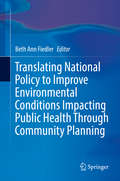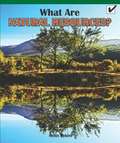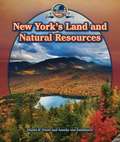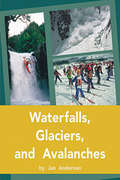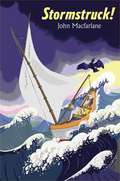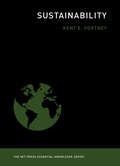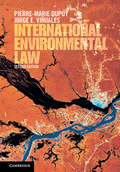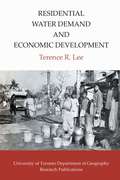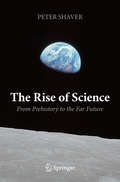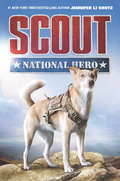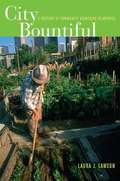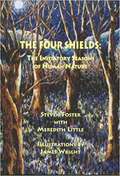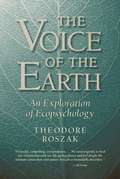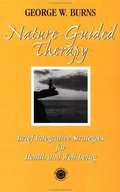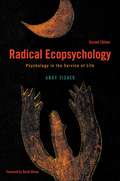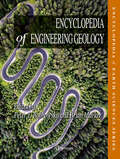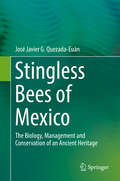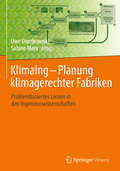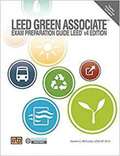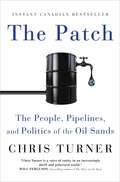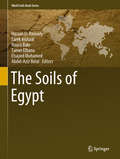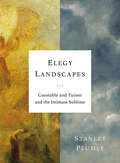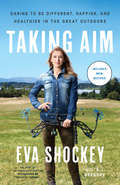- Table View
- List View
Translating National Policy to Improve Environmental Conditions Impacting Public Health Through Community Planning
by Beth Ann FiedlerThis first-of-its-kind volume traces rarely explored links between public policy, the state of the environment, and key issues in public health, with recommendations for addressing longstanding intractable problems. Experts across diverse professions use their wide knowledge and experience to discuss hunger and food sustainability, land use, chronic and communicable diseases, child mortality, and global water quality. Interventions described are varied as well, from green technology breakthroughs to regulatory accountability, innovative urban planning and community policing programs. Chapters build and expand on each other’s themes inspiring deeper understanding and critical thinking that further prompts readers to develop practical solutions leading to improvements in planetary and population health outcomes. Included in the coverage:· The challenge of implementing macroeconomic policy in an increasingly microeconomic world· Green aid flows: trends and opportunities for developing countries· Planning healthy communities: abating preventable chronic diseases· Foundations of community health: planning access to public facilities · International changes in environmental conditions and their personal health consequences Translating National Policy to Improve Environmental Conditions Impacting Public Health is developed for educators, students, and policymakers to generate awareness and review options to help create change in their communities. Federal agencies such as the Department of Health and Human Services, the National Institutes of Health, the EPA, and Housing and Urban Development will also find it salient.
What Are Natural Resources? (Real Life Readers)
by Nolan RobertThis eBook for Emerging Readers is an easy-to-use assessment tool in a series of 18 science and social studies titles. Teachers will be able to educate students on natural resources in today's world through full color photographs and easy-to-follow language.
New York's Land And Natural Resources (Spotlight on New York)
by Amelie Von Zumbusch Daniel R. FaustIntroduces the main geographical features of New York and describes the environmental views of Native Americans and early settlers, the struggle to control its resources, and the role of New York's waterways and minerals in its development.
Too Cold (Tidbit & Morsel)
by Kathy Schulz Ann CaranciTidbit is having a lot of fun playing in the woods, but it's too cold outside for Morsel.
Waterfalls, Glaciers, and Avalanches (Rigby PM Plus Non Fiction Ruby (Levels 27-28), Fountas & Pinnell Select Collections Grade 3 Level Q)
by Jan AndersonThis text focuses upon the movement and flow of water, ice and snow, and how this affects the environment and the lifestyles of the people who live there. Text forms include a labelled diagram, a diary excerpt and a newspaper report.
Stormstruck!
by John MacfarlaneBelieving his parents are going to euthanize Pogo, a beloved golden Labrador that had belonged to his deceased brother, twelve-year-old Sam sets sail with the dog and gets caught in a terrible storm along with Magnus, a hermit, and his pet tern, Fuego, whom they meet on an island.
Sustainability: Creating The Green Metropolis (MIT Press Essential Knowledge series)
by Kent E. PortneyA concise and accessible examination of sustainability in a range of contemporary contexts, from economic development to government policy.The word “sustainability” has been connected to everything from a certain kind of economic development to corporate promises about improved supply sourcing. But despite the apparent ubiquity of the term, the concept of sustainability has come to mean a number of specific things. In this accessible guide to the meanings of sustainability, Kent Portney describes the evolution of the idea and examines its application in a variety of contemporary contexts—from economic growth and consumption to government policy and urban planning.Portney takes as his starting point the 1987 definition by the World Commission on Environment and Development of sustainability as economic development activity that “meets the needs of the present without compromising the ability of future generations to meet their own needs.” At its heart, Portney explains, sustainability focuses on the use and depletion of natural resources. It is not the same as environmental protection or natural resource conservation; it is more about finding some sort of steady state so that the earth can support both human population and economic growth. Portney looks at political opposition to the promotion of sustainability, which usually questions the need for sustainability or calls its costs unacceptable; collective and individual consumption of material goods and resources and to what extent they must be curtailed to achieve sustainability; the role of the private sector, and the co-opting of sustainability by corporations; government policy on sustainability at the international, national, and subnational levels; and how cities could become models for sustainability action.
International Environmental Law: An Introduction
by Jorge E. Viñuales Pierre-Marie DupuyInternational Environmental Law offers a concise, conceptually clear, and legally rigorous introduction to contemporary international environmental law and practice. The book covers all major environmental agreements, paying particular attention to their underlying structure, main legal provisions, and practical operation. It blends legal and policy analysis, making extensive reference to the jurisprudence and scholarship, and addressing the interconnections with other areas of international law, including human rights, humanitarian law, trade and foreign investment. The material is structured into four sections - foundations, substantive regulation, implementation, and influence on other areas of international law - which help the reader to navigate the different areas of international environmental law. Each chapter includes charts summarising the main components of the relevant legal frameworks and provides a detailed bibliography. Suitable for practicing and academic international lawyers who want an accessible, up-to-date introduction to contemporary international environmental law, as well as non-lawyers seeking a concise and clear understanding of the subject.
Residential Water Demand and Economic Development (The Royal Society of Canada Special Publications #2)
by Terence LeeIn the last twenty years the problem of urban public water supples has become increasingly serious. Disparities between the effective supply of, and demand for, water has grown rapidly and now constitute a danger to public health. This study deals with the place of urban public water supplies in economic development and with the demand for such elements of the social infrastructure during the process of economic and social growth. Based on an examination of the existing water-use systems in two urban areas in India, this study provides valuable information in a field that is of growing concern to all the developing countries of the world.
Opal for 3rd Grade Student Edition Part Two (Mosdos Press Literature Series)
by Judith FactorAmasina was very pleased. The American doctors had decided to teach him how to carry out medical treatments used in the United States. They were also going to give him simple medical instruments and medications. He would be able to help the people of his tribe by giving injections, fluids, and antibiotics. Amasina would assist the doctors in return. He would share his knowledge about plants of the Amazon that he used to treat wounds and disease.
The Rise of Science: From Prehistory to the Far Future
by Peter ShaverHow did science rise up to so dramatically change our world, and where will it take us in the future? This book gives a unique and broad overview. A brief history reveals the major phases and turning points in the rise of science from the earliest civilizations to the present: How was science ‘discovered’? Why did it disappear a few times? When did it become ‘modern’? A critical assessment examines how science actually ‘happens’: the triumphs, the struggles, the mistakes and the luck. Science today is endlessly fascinating, and this book explores the current exponential growth, curiosity-driven vs. goal-oriented research, big and small science, the support of science, the relation of science to society, philosophy and religion, and the benefits and dangers of science. Finally a glimpse into the future: Will the current pace of science continue? Will we ever go backwards (again)? What remains to be discovered? Can science ever be complete? What can we imagine for the distant future? This book will be of wide interest to the general reader as well as to students and working scientists.This book provides a fresh, unique and insightful coverage of the processes of science, its impact on society and our understanding of the world, based on the author’s experience gained from a lifetime in science.Ron Ekers, FRS, CSIRO Fellow, CSIRO Astronomy & Space Science, former President of the International Astronomical UnionPeter Shaver's comprehensive and lively survey deserves a wide readership. Scientific discoveries are part of our global culture and heritage, and they underpin our lives. It's fascinating to learn how they were made, and how they fit into the grand scheme. This book isn't just for scientists - it's written for all of us.Martin Rees, FRS, Astronomer Royal, former President of the Royal Society and former Master of Trinity College, CambridgeThis book offers a wonderfully concise and accessible insight into science – its history, breadth and future prospects. Peter Shaver gives a feeling for what it actually means to be a practicing scientist.Stephen Simpson, FRS, Academic Director, Charles Perkins Centre, School of Life and Environmental Sciences, University of Sydney
Scout: National Hero (Scout #1)
by Jennifer Li ShotzFrom the #1 New York Times bestselling author Jennifer Li Shotz comes a whole new dog adventure full of courage and canine friendship. <P><P>Scout, once a stray puppy with a troubled past, has grown into one of the best search-and-rescue dogs in Mississippi. <P><P>And now he’s ready for bigger and better things: Scout is joining the National Guard. But Scout’s new life as a K9 recruit is far from easy as he adjusts to his challenging training and a brand-new family. <P><P>Twelve-year-old Matt is determined to help Scout feel at home in Nevada, but when a terrifying flash flood hits town, the pair must save the day and prove their worth. <P><P>As Scout and Matt team up to survive treacherous rising water, lead victims to safety, and attempt to rescue Matt’s sister, they quickly learn that bravery is just the first ingredient in the making of a hero. Does the duo have what it takes to protect their town from the fallout of this devastating disaster? <P><P> Perfect for fans of Max, Hero, and Cracker!
City Bountiful: A Century of Community Gardening in America
by Laura J. LawsonSince the 1890s, providing places for people to garden has been an inventive strategy to improve American urban conditions. There have been vacant-lot gardens, school gardens, Depression-era relief gardens, victory gardens, and community gardens―each representing a consistent impulse to return to gardening during times of social and economic change. In this critical history of community gardening in America, the most comprehensive review of the greening of urban communities to date, Laura J. Lawson documents the evolution of urban garden programs in the United States. Her vibrant narrative focuses on the values associated with gardening, the ebb and flow of campaigns during times of social and economic crisis, organizational strategies of these primarily volunteer campaigns, and the sustainability of current programs.
The Four Shields: The Initiatory Seasons of Human Nature
by Steven Foster Meredith LittleThe Four Shields: The Initiatory Seasons of Human Nature by Steven Foster and Meredith Little.
The Voice of the Earth an Exploration of Ecopsychology (2nd Edition)
by Theodore RoszakExamining perspectives on the connection between man's inner being and the outer world, this title covers topics such as the Anthropic Principle, Gaia Hypothesis, mysticism, religion, nature, and more.
Nature-Guided Therapy: Brief Integrative Strategies for Health and Well-Being
by George W. BurnsIt takes us on a cross-cultural journey into traditional healing disciplines, such as ethno-medicine, sociobiology, and anthropology. By examining clinical data, empirical scientific investigations, and anecdotal accounts, Dr. George Burns helps point the way to healing benefits of a balanced relationship with the environment.
Radical Ecopsychology: Psychology in the Service of Life (2nd Edition) (SUNY series in Radical Social and Political Theory)
by Andy FisherA provocative look at the philosophical concepts (and conceits) that underlie what truly is a radical new form of social thought.
Encyclopedia of Engineering Geology (Encyclopedia Of Earth Sciences Ser.)
by Peter T. Bobrowsky Claudio Margottini Paul Marinos Brian Marker Martin G. Culshaw Jerome De Graff Laurance Donnelly Michael Hendry Jeffrey R. Keaton Victor Osipov Abdul Shakoor Roy ShlemonThis volume addresses the multi-disciplinary topic of engineering geology and the environment, one of the fastest growing, most relevant and applied fields of research and study within the geosciences. It covers the fundamentals of geology and engineering where the two fields overlap and, in addition, highlights specialized topics that address principles, concepts and paradigms of the discipline, including operational terms, materials, tools, techniques and methods as well as processes, procedures and implications.A number of well known and respected international experts contributed to this authoritative volume, thereby ensuring proper geographic representation, professional credibility and reliability. This superb volume provides a dependable and ready source of information on approximately 300 topical entries relevant to all aspects of engineering geology. Extensive illustrations, figures, images, tables and detailed bibliographic citations ensure that the comprehensively defined contributions are broadly and clearly explained.The Encyclopedia of Engineering Geology provides a ready source of reference for several fields of study and practice including civil engineers, geologists, physical geographers, architects, hazards specialists, hydrologists, geotechnicians, geophysicists, geomorphologists, planners, resource explorers, and many others. As a key library reference, this book is an essential technical source for undergraduate and graduate students in their research. Teachers/professors can rely on it as the final authority and the first source of reference on engineering geology related studies as it provides an exceptional resource to train and educate the next generation of practitioners.
Stingless Bees of Mexico
by José Javier Quezada-EuánThe stingless bees are the most diverse group of highly social bees and are key species in our planet’s tropical and subtropical regions, where they thrive. In Mexico, the management of stingless bees dates back centuries, and they were an essential part of the culture and cosmogony of native peoples like the Maya. In recent decades a vast amount of information has been gathered on stingless bees worldwide. This book summarizes various aspects of the biology and management of stingless bees, with special emphasis on the Mexican species and the traditions behind their cultivation. Much of the information presented here was produced by the author and the team of researchers at the Universidad Autónoma de Yucatán in the course of three decades of working with these insects. Given the breadth of its coverage, the book offers an equally valuable reference guide for academics, students and beekeepers alike.
KlimaIng - Planung klimagerechter Fabriken: Problembasiertes Lernen In Den Ingenieurwissenschaften
by Uwe Dombrowski Sabine MarxDie mit dem Klimawandel verbundenen Risiken haben auch Konsequenzen für produzierende Unternehmen und ihre Produktionsstätten. Daher widmet sich das Buch der klimagerechten Planung von Fabriken und verknüpft dieses ingenieurwissenschaftliche Fachgebiet mit Grundlagenwissen zur Planung und Durchführung problembasierter Lehrveranstaltungen an Hochschulen. Im ersten Teil beschreiben die Autoren die Grundlagen des Klimawandels und der Fabrikplanung. Sie stellen zum einen die Vorgehensweisen zur Identifizierung von Klimarisiken und zum anderen Planungsansätze zu deren Reduzierung vor. Der zweite Teil verknüpft diese ingenieurwissenschaftlichen Aufgabenstellungen mit dem Konzept problembasierten Lernens. Dabei wird problembasiertes Lernen als Lehrmethode zum Erwerb und zur Anwendung praxisrelevanten Fachwissens verstanden, die stets die Lernenden in den Mittelpunkt stellt. Neben theoretischen Grundlagen und aktuellen Forschungsergebnissen zur Wirksamkeit problembasierten Lernens erhalten Leser hier auch Hinweise für die Implementation in der Praxis. Am Beispiel einer problembasierten Lehrveranstaltung, die im Rahmen eines Forschungsprojektes entwickelt wurde, wird eine didaktische Konzeption zur Planung und Durchführung problembasierter Lernumgebungen vorgestellt. Diese Modell-Lehrveranstaltung ist so aufbereitet, dass das Konzept ohne viel Aufwand auf andere Themengebiete der Ingenieurwissenschaften übertragen werden kann. Der dritte Teil des Buchs bietet eine Fallsammlung zu unterschiedlichen Lernzielen. Diese dienen Nutzern als Vorlage, um selbst geeignete Fälle für problembasierte Lernumgebungen zu konstruieren. Das Buch richtet sich an Lehrkräfte in ingenieurwissenschaftlichen Studiengängen, insbesondere solche mit dem Schwerpunkt Klimawandel und Fabrikplanung.
LEED Green Associate Exam Preparation Guide (v4 Edition)
by Heather C. McCombs<p>The LEED Green Associate Exam Preparation Guide, LEED v4 Edition is designed to help you pass the LEED Green Associate exam. The exam prep guide captures the critical points you need to know about green building. It also reflects the structure of the exam knowledge and task domains to organize foundational concepts in green building and LEED. <p>The exam prep guide will help you prepare for the exam by emphasizing key terms and providing application learning through practice questions. This resource is intended to be used in conjunction with the exam primary references, including the LEED Core Concepts Guide. Access to a variety of digital resources that enhance learning is also included with this guide.</p>
The Patch: The People, Pipelines, and Politics of the Oil Sands
by Chris TurnerBestselling author Chris Turner brings readers onto the streets of Fort McMurray, showing the many ways the oilsands impact our lives and demanding that we ask the question: In order to both fuel the world and to save it, what do we do about the Patch?In its heyday, the oilsands represented an industrial triumph and the culmination of a century of innovation, experiment, engineering, policy, and finance. Fort McMurray was a boomtown, the centre of a new gold rush, and the oilsands were reshaping the global energy, political, and financial landscapes. The future seemed limitless for the city and those who drew their wealth from the bitumen-rich wilderness. But in 2008, a new narrative for the oilsands emerged. As financial markets collapsed and the scientific reality of the Patch’s effect on the environment became clear, the region turned into a boogeyman and a lightning rod for the global movement combatting climate change. Suddenly, the streets of Fort McMurray were the front line of a high-stakes collision between two conflicting worldviews—one of industrial triumph and another of environmental stewardship—each backed by major players on the world stage. The Patch is the seminal account of this ongoing conflict, showing just how far the oilsands reaches into all of our lives. From Fort Mac to the Bakken shale country of North Dakota, from Houston to London, from Saudi Arabia to the shores of Brazil, the whole world is connected in this enterprise. And it requires us to ask the question: In order to both fuel the world and to save it, what do we do about the Patch?
The Soils of Egypt (World Soils Book Series)
by Hassan El-Ramady Tarek Alshaal Noura Bakr Tamer Elbana Elsayed Mohamed Abdel-Aziz BelalThis book reviews the distribution of soils across Egypt, their history, genesis, pollution and management. The conservation of Egyptian soils, soils and their connections to human activities, as well as some future soil issues are also highlighted. It is well known that soil is the main source for food, feed, fuel and fiber production. Accordingly, the study of soils is not only a crucial issue but also an urgent task for all nations worldwide. Due to their important roles in agroecosystems as well as many aspects of our lives, soils have direct and indirect functions in the agricultural, industrial and medicinal sectors. Therefore, understanding the physical, chemical and biological properties of soils, as well as soil security, have now become emerging issues. Climate change has a very dangerous dimension in Egypt concerning the rising sea level. Many coastal zones are already threatened by this sea level rise, and may ultimately disappear. At the same time, water shortages and soil pollution represent the main challenges for the Egyptian nation. Generally speaking, the environmental challenges that Egypt now faces include improving and sustaining soil health, soil carbon sequestration, wastewater treatment, and avoiding the overuse of fertilizers and pesticides. Therefore, this book examines in detail the soils of Egypt from various perspectives including their genesis, history, classification, pollution and degradation, soil security, soil fertility and land uses.
Elegy Landscapes: Constable And Turner And The Intimate Sublime
by Stanley PlumlyA sweeping look at the lives and work of two important English Romantic painters, from a Los Angeles Times Book Prize–winning author. Renowned poet Stanley Plumly, who has been praised for his “obsessive, intricate, intimate and brilliant” (Washington Post) nonfiction, explores immortality in art through the work of two impressive landscape artists: John Constable and J.M.W. Turner. How is it that this disparate pair will come to be regarded as Britain’s supreme landscape painters, precursors to Impressionism and Modernism? How did each painter’s life influence his work? Almost exact contemporaries, both legendary artists experience a life-changing tragedy—for Constable it is the long illness and death of his wife; for Turner, the death of his singular parent and supporter, his father. Their work will take on new power thereafter: Constable, his Hampstead cloud studies; Turner, his Venetian watercolors and oils. Seeking the transcendent aesthetic awe of the sublime and reeling from their personal anguish, these talented painters portrayed the terrible beauty of the natural world from an intimate, close-up perspective. Plumly studies the paintings against the pull of the artists’ lives, probing how each finds the sublime in different, though inherently connected, worlds. At once a meditation on the difficulties in achieving truly immortal works of art and an exploration of the relationship between artist and artwork, Elegy Landscapes takes a wide-angle look at the philosophy of the sublime.
Taking Aim: Daring to Be Different, Happier, and Healthier in the Great Outdoors
by A. J. Gregory Eva ShockeyAn acclaimed bow hunter who defies the stereotype that hunting is a man’s game, Eva Shockey is a TV and social media phenomenon at the forefront of a new wave of women and girls who are passionate about outdoor sports. Eva Shockey grew up expecting to be a dancer like her glamorous mother. But something about spending family vacations RV-ing across North America and going on hunts with her dad sparked in her an enduring passion for a different way of life. In Taking Aim, Eva tells a very personal story of choosing the less-traveled path to a rewarding life in outdoor pursuits like hunting and fishing. For her, as her millions of fans can attest, that has meant hunting as a way of harvesting food, caring deeply about conservation, sustainability and healthy eating, and getting closer to God in nature. In this riveting memoir for the adventurer in all of us, Eva takes readers along as she hunts caribou on the rugged Aleutian Islands, tracks a 1,500-pound bull moose across the unforgiving Yukon, and meets many other challenges of a life in the wild. Along the way we learn that hunting is about so much more than pulling a trigger. "My story is about discovering your dream," writes Eva. "It's about following your passion, mastering your skills, taking aim no matter who thinks you’re crazy…and then letting the arrow fly. If you’ve done all you can, I can tell you that you’re almost certain to hit your mark." Whether you’re a lifelong hunter or a city dweller who has never set foot in the wilderness, Eva’s story delivers an empowering message about rejecting stereotypes and expectations, believing in yourself, and finding the courage to pursue what you care about most.
